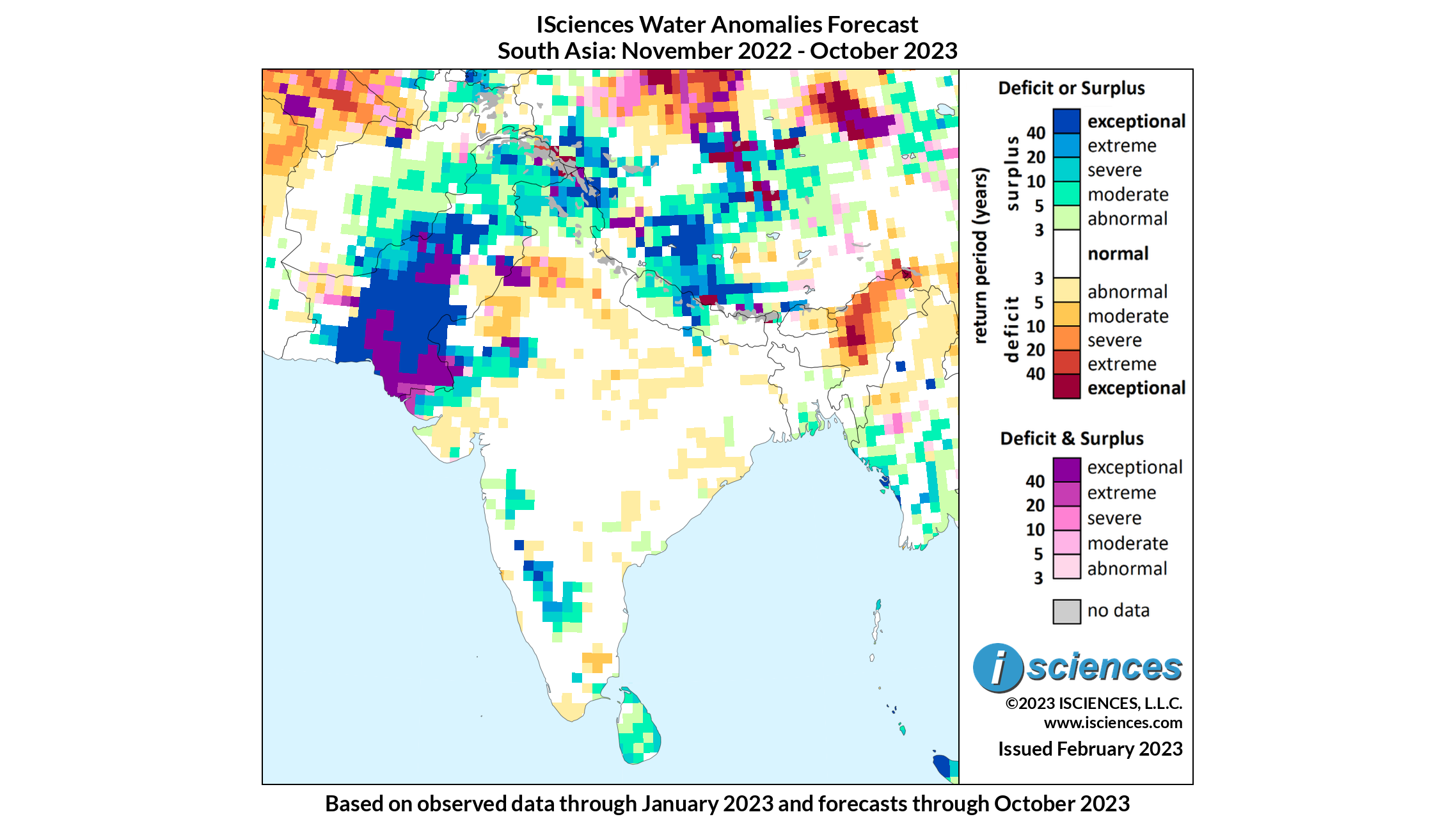South Asia: Intense surpluses in Pakistan to persist
1 March 2023
THE BIG PICTURE
The 12-month forecast ending in October 2023 anticipates continued exceptional surplus in regions of Pakistan, with northern regions experiencing similarly intense surplus.
Severe to exceptional surplus is expected in:
Much of southern to central Pakistan, spreading across the border into western India. Southernmost areas of Pakistan, specifically near the city of Karachi, will also experience intense transitional conditions.
Southern India, throughout the region of Karnataka.
Southeastern Afghanistan, in regions along the border of Pakistan.
Central Nepal.
Southwestern coastal regions of Sri Lanka.
Moderate surpluses is anticipated in:
Far northern and western India, with the highest intensities in Himachal Pradesh and northern Gujarat.
Throughout Sri Lanka.
Western Nepal.
Northern Pakistan, north of the Chenab River.
Deficits are forecast in:
Central to northern Bangladesh, with extreme to exceptional deficits affecting regions along the Brahmaputra River.
Northern India, with moderate deficits near the city of Ludhiana.
FORECAST BREAKDOWN
The forecast through April 2023 indicates that exceptional surpluses in southern Pakistan and western India will become transitional conditions, spreading further east to cover much of central India, combined with sparse pockets of moderate deficits. Intense surpluses are forecast from central and northern Pakistan through northern India, passing through Nepal and into southern Bangladesh. Eastern Afghanistan can expect surpluses of mild to moderate intensity.
From May through July 2023, near-normal conditions will return to much of Indonesia and Pacific regions, with surpluses persisting in central Vietnam and the central Philippines. Moderate deficits are expected to occur in western Malaysia, near Perak.
The forecast for the final months – August through October 2023 – indicates continued near-normal conditions throughout the area, with small instances of moderate to severe deficits occurring in western Malaysia, central Philippines, and areas along the shared border of Papua and Papua New Guinea.
Please note that WSIM forecast skill declines with longer lead times.
IMPACTS
A new study reports that around 15 million people across the world face the risk of sudden and deadly flooding from glacial lakes, including millions of people in Pakistan already inflicted by the region’s unprecedented flooding crisis. Glacial lakes result from shrinking glaciers, which cause flooding in downstream areas once water begins to release from them. Deluges from glacial lakes are referred to as glacial lake outburst floods, or GLOFs. GLOFs appear with little warning and have increased multifold due to climate change, causing major damage to property, farmland, and infrastructure, as well as hundreds of deaths. Tom Robinson, a co-author of the study, stated that as the climate continues to warm, “glacier retreat will form larger and more numerous lakes,” and that “lakes are likely to become more exposed to GLOF ‘triggers’, such as a large landslide or ice avalanche entering the lake, displacing water, and causing the natural dam that impounds the lake to fail.”
The catastrophic 2022 floods in Pakistan are worsening the country’s worst economic crisis since its creation, destroying at least 45% of its cotton crop and crippling its textile sector. As a result, the textile industry is facing a significant 14.8% decrease in exports and workers are preparing for massive layoffs in the workforce. Last month, the value of total exports from Pakistan was recorded at $1.3 billion, a decline from January 2021’s report of $1.5 million. Over one million citizens are potentially affected by the industry-wide layoffs, which compounds with January’s announcement from Pakistan’s textile associations that around 7 million people working in the textile sector and related industries had lost their jobs since last summer.
NOTE ON ADMINISTRATIVE BOUNDARIES
There are numerous regions around the world where country borders are contested. ISciences depicts country boundaries on these maps solely to provide some geographic context. The boundaries are nominal, not legal, descriptions of each entity. The use of these boundaries does not imply any judgement on the legal status of any territory, or any endorsement or acceptance of disputed boundaries on the part of ISciences or our data providers.
Subscribe to our monthly Water Watch List
Search blog categories
- *Precip/Temp Outlooks 101
- *Press Releases 1
- *Special Topics 19
- *Water Watch Lists 119
- Africa 129
- Australia & New Zealand 113
- Canada 115
- Central Asia & Russia 113
- East Asia 114
- Europe 120
- Mexico & C. Amer. & Carib 118
- Middle East 123
- Proof Point 1
- South America 128
- South Asia 119
- Southeast Asia & Pacific 122
- United States 119
Search blog tags



